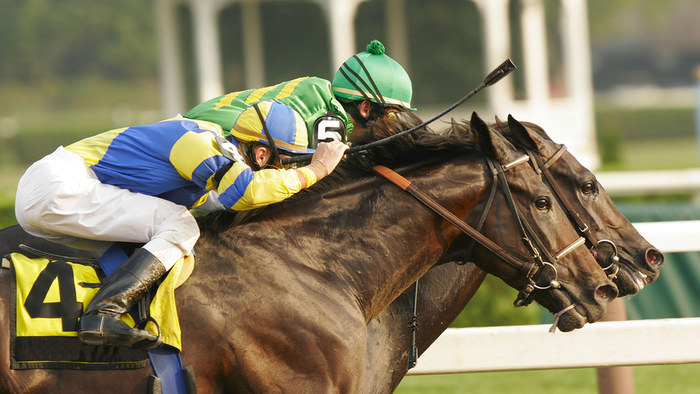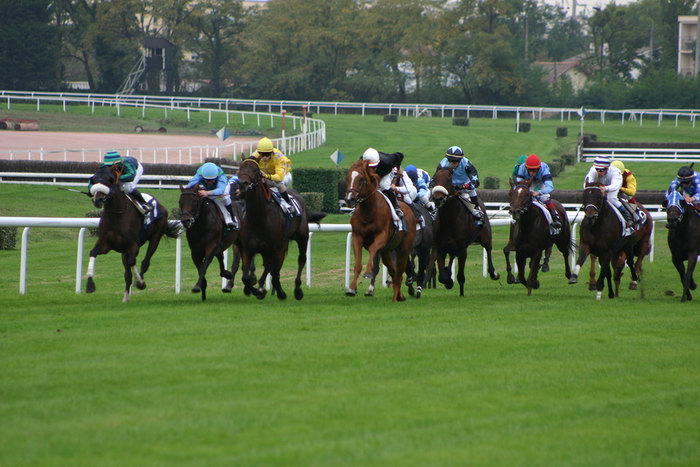 If you don’t know your Grade 1s from your Group 3s or your Heritage Handicaps from your Bumpers, you’ve come to the right place.
If you don’t know your Grade 1s from your Group 3s or your Heritage Handicaps from your Bumpers, you’ve come to the right place.
Here we will delve into the seemingly complex world of how different horse races are classified and we will give the details of the main classifications of races for both flat and National Hunt (jumps) racing.
Official Racehorse Ratings

With so many horses currently involved in the sport of horse racing (around 15,000 in the UK alone at the last count!) it becomes a truly mammoth task trying to keep track of which horses are of a similar standard to others. This is important because failure to produce fields that contain horses of a roughly similar standard would lead to uncompetitive races and would mean that no one would truly know which horses were better than any others unless they raced one another on the course. That is where the British Horseracing Authority (BHA) comes in.
The BHA is responsible for giving each race horse an official rating that indicates how good that particular horse is. This rating, coupled with the systems of handicapping, allows races to be set up on as close to a level playing field as is realistically possible. While the rating and handicap systems are not exact sciences and there are still plenty of mismatches in which a particular horse might romp to victory by 10 lengths or more, the BHA ensure that – as far as is possible – horses of a similar standard compete against one another.
Which leads onto the various grades, groups and classes or horse races. Horses are distributed across a range of standards in terms of their speed, stamina and reliability and a wide range of race classifications have been developed so that horses can be entered into the ‘right’ level of race for them. Horses are entered into different classes of race depending on their official rating. Below we give the details of the various race classifications for both flat racing and National Hunt, with information about the different types of races.
Flat Racing

Flat races are split into seven classes with Class 1 being the best, most prestigious, going right down to Class 7 races for, well, no-hopers. Each class incorporates a number of different types and standards of race, which are detailed as follows.
Race Types
- Group 1, Group 2 and Group 3 races – The top level of races, with many of the most prestigious races – including the five Classics of flat racing – classified as Group 1 races. Horses carry the same weight as one another in these races, though small weight allowances are generally given to fillies and mares in races in which they race against male horses.
- Listed Races – Along with the Group races, Listed races are part of Class 1 band of races, though these – which can be handicaps or not – are slightly less prestigious than the Group races.
- Handicaps – The weight carried by the runners is determined by the official rating. Handicaps are split into different classes depending on the rating band within which the runners fall.
- Classified Stakes – Restricted to horses with ratings below a specified level, and who have raced at least three times or twice with at least one victory.
- Conditions Stakes – The weight carried by the runners is based on the age and sex of the horse rather than the official rating, with more weight carried by males and older runners.
- Claiming Stakes – Horses are given a maximum weight they can carry and this is used to set the price for which runners can be purchased after the race.
- Seller – The winners of these races are sold in a public auction afterwards.
- Maiden – Mainly for two-year-old runners and those who have never won a race. A win at a maiden race allows a horse to be given an official rating and they are thus able to enter handicap races. A horse will be given a rating after three maiden races even if they don’t manage to win one.
- Maiden Auction – Runners are sold after the race with the price being at or below a specified value.
- Median Auction Maiden – Restricted maiden races whereby the median price of the runners must be below a set maximum.
- Novices’ – Race for runners of two or three years of age who have not won more than two races previously.
- Novice Auction – Like the Maiden Auction, for novices.
- Novice Median Auction – As the Median Auction Maiden, for novices.
- Nursery – A handicap race open to two-year-olds only.
- Amateurs – Races in which only amateur jockeys may compete.
Flat Race Classifications
The above race types are distributed across the seven classes of flat racing, with the official rating or race value often determining which class the particular race will fall into. The race value and official rating conditions are correct at the time of writing (October 2015) but may be subject to change in the future if the BHA sees fit.
Class 1
- Group 1 – With minimum race value of £200,000 (3yo+) and £150,000 (2yo+).
- Group 2 – With minimum race value of £90,000 (3yo+) and £65,000 (2yo+).
- Group 3 – With minimum race value of £60,000 (3yo+) and £40,000 (2yo+).
- Listed – Including Listed Handicap with horses rated 96-100. With minimum race value of £37,000 (3yo+) and £25,500 (2yo+).
Class 2
- Heritage Handicaps – With minimum race value of £100,000.
- Handicaps – For horses with an official rating of 0-105, 0-110 or which are Open, with a minimum value of £45,000
- Conditions Stakes
- Handicaps – For horses with an official rating of 86-100, 91-105 and 96-110
- Nursery Handicaps – Open
- Classified Stakes – For horses with an official rating of 0-95
- Novices’ and Maidens – With minimum race value of £19,000 (3yo+) and £14,000 (2yo+)
Class 3
- Conditions Stakes – With maximum race value of £25,000 (3yo+) and £19,000 (2yo+)
- Handicaps – For horses with an official rating of 76-90 and 81-95
- Classified Stakes – For horses with an official rating of 0-85 and 0-90
- Nursery Handicaps – For horses with an official rating of 0-90 and 0-95
- Novices’ and Maidens – With minimum race value of £11,500 (3yo+) or £10,000 (2yo+)
Class 4
- Conditions Stakes – With maximum race value of £12,500 (3yo+) and £11,000 (2yo+)
- Handicaps – For horses with an official rating of 66-80 and 71-85
- Classified Stakes – For horses with an official rating of 0-80
- Nursery Handicaps – For horses with an official rating of 0-80 and 0-85
- Novices’, Novice Auction, Novice Median Auction
- Maidens, Maiden Auction, Median Auction Maiden
- Claimers and Sellers – With minimum race value of £7,250 (3yo+) and £6,100 (2yo+).
Class 5
- Handicaps – For horses with an official rating of 56-70 and 61-75, with maximum race value of £8,000 (3yo+) and £7,000 (2yo+).
- Nursery Handicaps and Classified Stakes – For horses with an official rating of 0-70 and 0-75
- Novice Auction, Novice Median Auction
- Maiden Auction, Median Auction Maiden, Rating Related Maiden
- Claimers and Sellers – With minimum race value of £4,500 (3yo+) and £4,500 (2yo+).
Class 6
- Handicaps – For horses with an official rating of 46-60 and 51-65, with maximum race value of £5,000 (3yo+) and £5,000 (2yo+)
- Nursery Handicaps and Classified Stakes – For horses with an official rating of 0-60 and 0-65
- Novice Auction, Novice Median Auction
- Maiden Auction, Median Auction Maiden, Rating Related Maiden
- Claimers and Sellers – With minimum race value of £3,500 (3yo+) and £3,500 (2yo+).
Class 7
- Handicaps – For horses with an official rating of 45-50
National Hunt Racing (Jump Racing)

National Hunt (jumps) racing has a similar class system, but instead of Groups 1, 2 and 3, the best National Hunt races are Grade 1, Grade 2 and Grade 3 – just to keep us all on our toes!
Race Types
- Grade 1, Grade 2 and Grade races – From the most prestigious Grade 1 races such as the Cheltenham Gold Cup, through the famous Grade 3 handicaps like the Grand National, the graded races are the richest, most popular and often most fiercely contested of the National Hunt races. These all fall into the top class of jumps racing, have the largest purses and attract the best horses, trainers and jockeys. Grade 1 races include all the championship level events, Grade 2 races include some weight penalties for past wins, and Grade 3s tend to be open handicaps with large prize funds.
- Listed Races – Listed races are also in the top class of jumps racing but tend to be slightly less prestigious than the graded events.
- Hurdle – A race in which runners must jump over hurdles, which are smaller and more forgiving than fences.
- Chase – A chase – or steeplechase – requires runners to negotiate fences, which are generally taller, broader and less forgiving than hurdles.
- Handicap Hurdle/Chase – The weight carried by the runners is based on the official rating of the horse, as with handicaps in flat racing.
- National Hunt Flat (Bumpers) – National Hunt races with no hurdles or fences, often used for horses who have not previously run in order to gain experience of running at a race course.
- Maiden Hurdle/Chase – Races for horse who have not previously won a race of that type (hurdle or chase).
- Novices’ Hurdle – Races for horses who had not won a hurdle race prior to the commencement of the current National Hunt season. A horse who has won a similar event in the current season would be required to carry extra weight.
- Beginners’ Chase – Races for horses who had not won a chase race prior to the commencement of the current National Hunt season. A horse who has won a similar event in the current season would be required to carry extra weight.
- Novices’ Handicap – A race open to horses who had not won a race prior to the start of the current season.
- Juvenile Novice Hurdle – A race for horse aged three at the start of the season.
- Claiming Stakes – A race in which the weight carried by the horses is based on the price placed upon them, lower prices giving lower weights. Owners and trainers can purchase (claim) a horse at the given price after the race.
- Selling Hurdle/Chase – Races in which the winner is offered to public auction afterwards.
- Hunters’ – Races competed by horses that have been used for hunting, featuring amateur jockeys only.
- Conditions Races – Races in which the weight carried is based on the age and sex of the runners rather than the official ratings.
- Amateurs – Races competed by horses ridden by amateur jockeys only.
National Hunt Race Classifications
As with flat racing, the National Hunt race types are split between various classes, six in this case (as opposed to the seven of flat racing). As with Flat classes, all race value and rating parameters are correct at the time of writing (October 2015) but are subject to change by the BHA.
Class 1
- Grade 1 – Races with a minimum value of £100,000 (chases) or £75,000 (hurdles).
- Grade 2 – Races with a minimum value of £50,000 (chases) or £40,000 (hurdles).
- Grade 3 – Races with a minimum value of £40,000 (chases) or £35,000 (hurdles).
- Listed – Races with a minimum value of £27,500 (chases) or £22,000 (hurdles).
Class 2
- Open Handicaps – Races with a minimum value of £22,500 (chases) or £18,500 (hurdles).
- Conditions Races – Weight based on the age of the runners.
- Handicaps – For horses with an official rating of 0-145+.
- Novices’ Handicaps – Open to horses of all ratings.
- Juvenile, Novices’ and Beginners’ Races – Weight based on the age of the runners.
- National Hunt Flat
- Hunters’ Chases – Races with a minimum value of £18,500 (chases) or £15,000 (hurdles).
Class 3
- Novices’ Handicap Chases – Open races with a maximum value of £25,000 (chases) or £20,000 (hurdles).
- Handicaps and Novices’ Handicaps – For horses with an official rating of 0-125 or 0-140.
- Novices’, Beginners’, Juvenile and Maiden – Weight based on the age of the runners.
- National Hunt Flat
- Hunters’ Chases – Races with a minimum value of £10,000 (chases) or £8,300 (hurdles).
Class 4
- Handicaps and Novices’ Handicaps – Races with a maximum value of £11,500 (chases) or £10,000 (hurdles) for horses with ratings of 0-105 or 0-120.
- Novices’, Beginners’, Juvenile and Maiden – Weight based on the age of the runners.
- Claiming and Selling Races – Weight based on the age of the runners.
- National Hunt Flat
- Hunters’ Chases – Races with a minimum value of £5,8000 (chases) or £5,000 (hurdles).
Class 5
- Handicaps and Novices’ Handicaps – Races with a maximum value of £7,000 (chases) or £6,000 (hurdles) for horses with an official rating of 0-100.
- Maiden Races – Weight based on the age of the runners.
- Claiming, Selling and Selling Handicaps – Weight based on the age of the runners.
- National Hunt Flat
- Hunters’ Chases – Races with a minimum value of £3,800 (chases) or £3,500 (hurdles).
Class 6
- National Hunt Flat – Races with a maximum value of £3,799 (chases) or £3,499 (flat).
- Hunters’ Chases – Races with a minimum value of £1,500 (chases) or £2,400 (flat).
